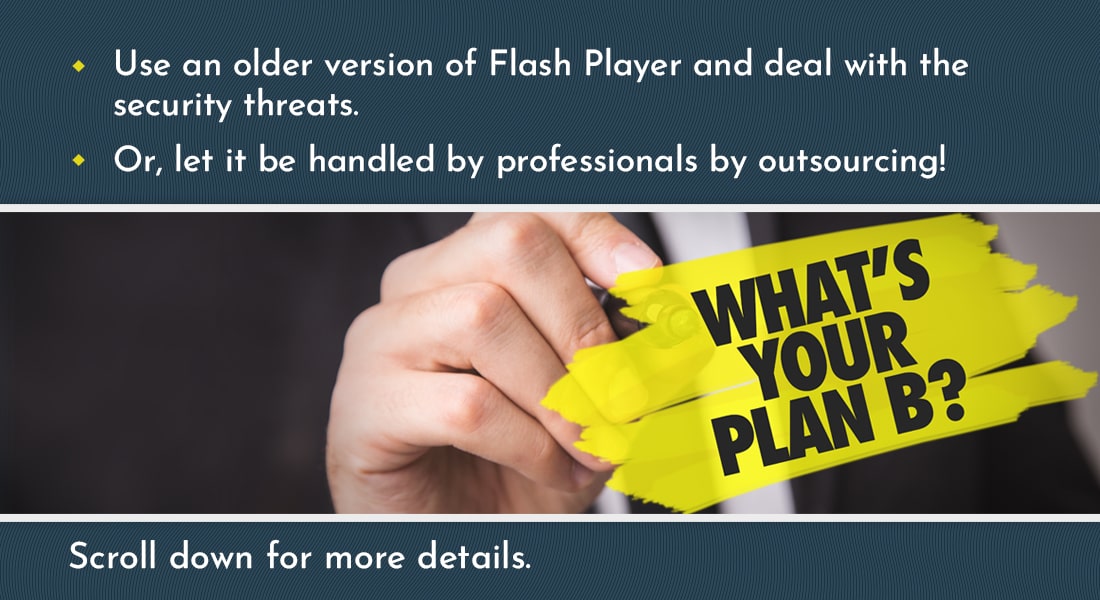How to Carry out Flash to HTML5 Conversion After the Phase-out

Back in 2017, Adobe announced that it is going to end Flash by 2020. While this was not totally unexpected considering major tech companies like Apple, YouTube, and Google had already either banned or restricted the use of Flash, it was still a blow for corporate L&D because for decades, Flash was their go-to tool to create eLearning courses. We spent the past three years urging organizations to start the Flash to HTML5 conversion of their eLearning courses. Now, the end of the 2020 deadline has come and gone. So…what’s next?
Flash to HTML5 Conversion Plan after the Phase-out
- Search for older versions of Flash Player with no built-in kill switch
- Set-up a virtual system to reduce the security threat
- Look for external open-sourced Flash Player emulators
- Outsource Flash to HTML5 conversion to a vendor
What does it mean for your remaining legacy courses now that Flash has stopped working? Can you still convert your Flash eLearning courses to HTML5? If that is not possible, are there any other ways to make it happen? These are a few of the questions I’ll be discussing in this blog today.
Flash to HTML5 Conversion: The After 2020 Phase Out
1. What’s the Current Status with Adobe Flash and Flash Player?

If you have tried using Flash player this past month, you must have seen this message flashing on your screen. And to clear out any confusion about the current status in the matter, here’s what we know for sure:
- Flash files will not play in any browser anymore because all external plug-ins for playing Flash content have been disabled. That means your Flash-based legacy courses can’t be played on browsers anymore.
- You can’t download the Flash player from an official source because Adobe has disabled all download links from its website.
- Even if you have downloaded a version of Flash Player 32.0.0.387 or beyond, you can’t use it because Adobe has included a kill switch in these versions, and hence it will no longer be functional.
- If you have any older version of the Flash player in your system, say 32.0.0.371 or its predecessors, you can technically use it to run Flash files, but we do not recommend doing it because of the security reasons that have hounded Flash until its phase-out. And now that there is no longer any proprietary support from Adobe, it’s better you uninstall it from your system as soon as possible.
2. What’s Plan B for Flash to HTML5 Conversion?
Based on what we have seen till now, the door to Flash to HTML5 conversion does seem to be closed. But wait, as the saying goes, ‘Where there’s a will, there’s a way’. And even if the deadline is past, there are a few ways we can still carry out Flash to HTML5 conversion for your legacy courses.
- Even though Flash files can’t be played in browsers, they can still play in the older version of the Flash player. And to reduce the security threat, you can set up a virtual machine, install Flash 32.0.0.371 and a compatible browser, and import all your Flash files into the system. Once the files start running, you can use a screen recording app to record the course in MP4 format.
- There are still some open-source Flash player emulators like Ruffle, Lightspark, etc. that can play .swf files. You can use them to play Flash-based eLearning courses as well.
- Once you get those Flash-based .swf files to play in any Flash player, you can extract the content and multimedia assets, import them to a new authoring tool, and republish them in HTML5 format. You can also use them to rebuild and update a course with a new instructional design strategy.
- If you have Flash-based video files in .flv format, you don’t need to go through all this hassle with a player or Flash-emulator. Many free media players like VLC and MPV support videos in .flv format. Though it will be a lot easier to simply convert them to MP4.
Put Your Best Foot Forward: Outsource Flash to HTML5 Conversion
Before deciding on how to move forward with this, let’s first weigh all the options you have.
Option 1
Forget about your legacy courses and start designing and developing eLearning courses in HTML5 from scratch.
This is a lose-lose option because you will lose all those courses you have developed over the years and spend extra dollars to build a brand-new eLearning curriculum.
Option 2
Check if you have an older version of Flash Player or an external Flash Player emulator, set up a virtual system to play your Flash files, and convert them to HTML5 format.
This is a better option, but you have to be very very careful about the security issues.
Option 3
Let go of all the hassle and outsource your Flash to HTML5 conversion project to professional eLearning developing vendors who can successfully deal with this problem on your behalf.
Don’t you think this is the best option?
End Note
I hope this blog gave you all the information you needed for Flash to HTML5 conversion when you seriously needed it. And I hope you won’t delay this time, because once this grace period is over, I doubt there’s going to be another loophole to recover those Flash-based legacy courses.
In the meantime, take a look at our eBook on Flash to HTML5 conversion strategies.





